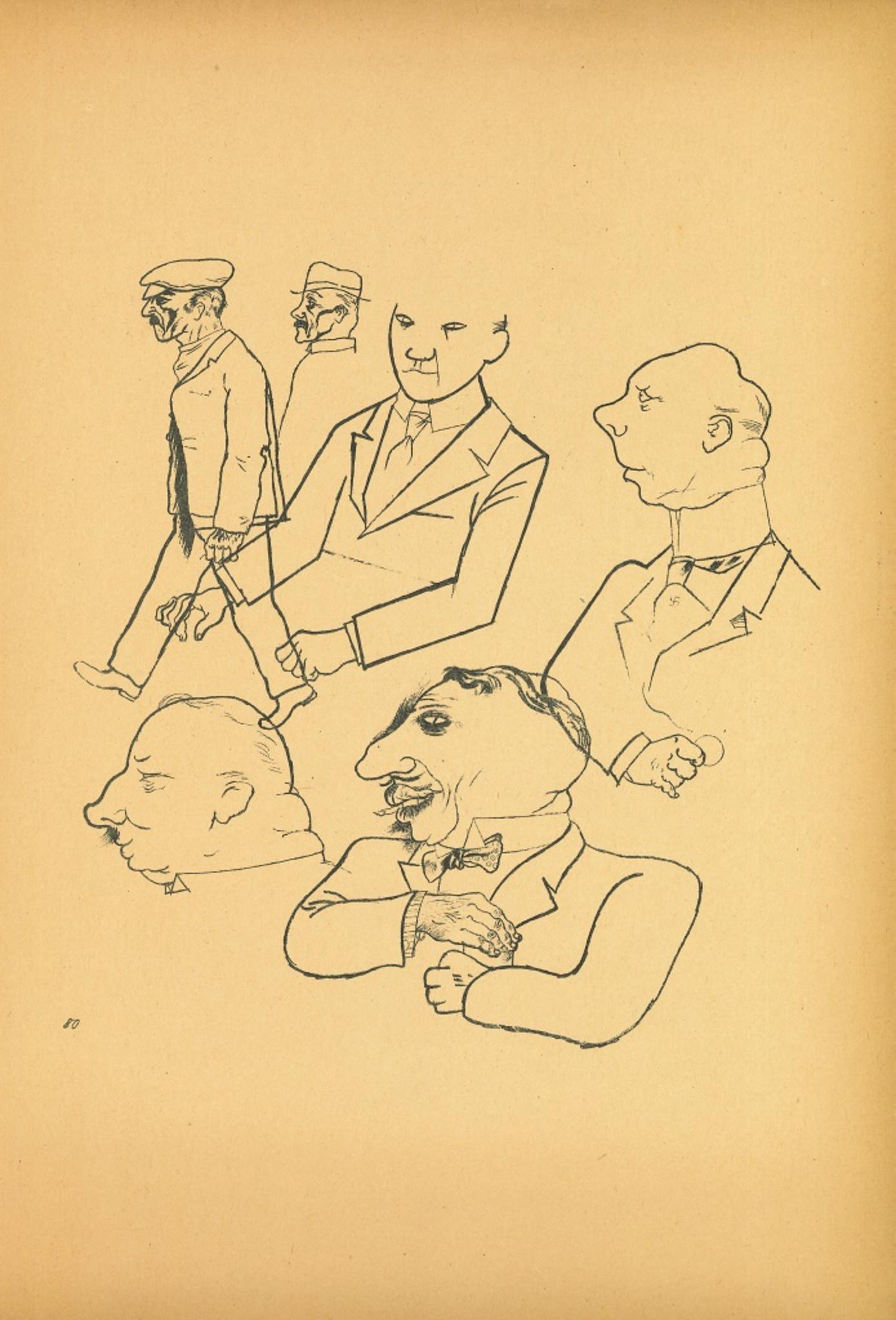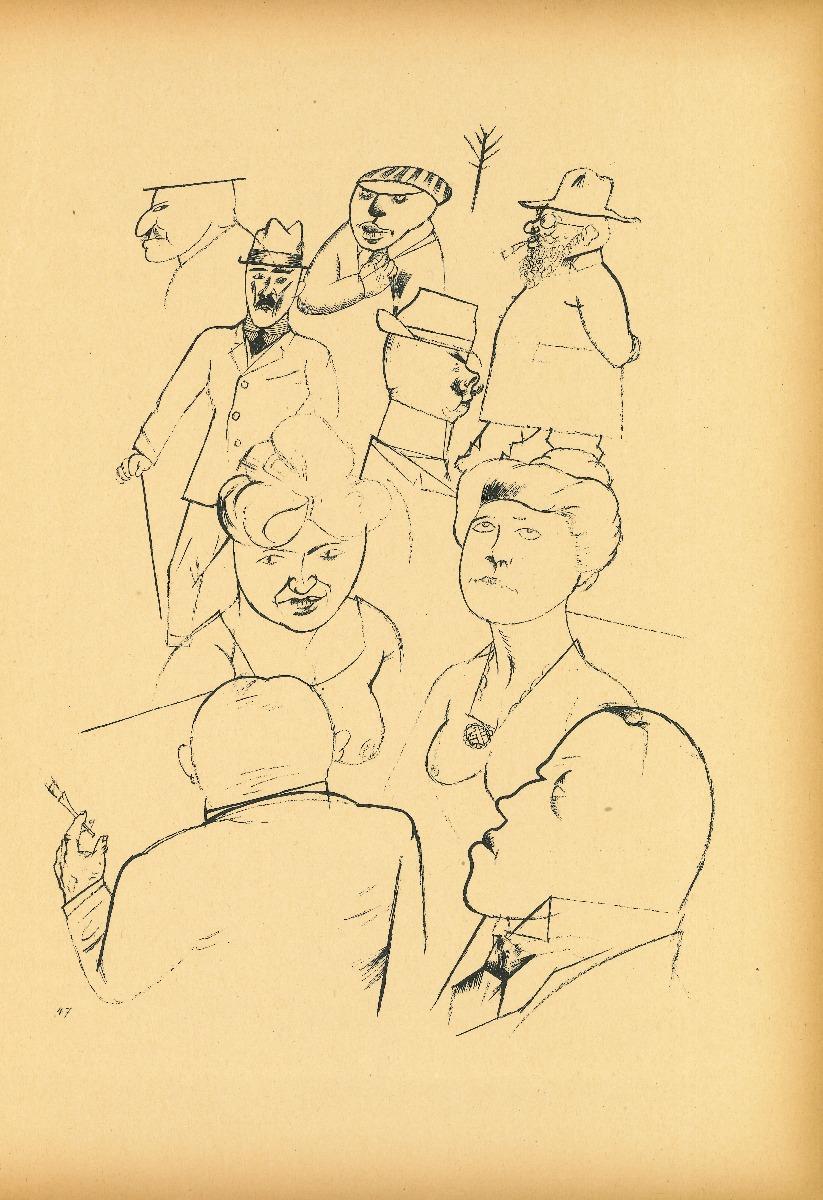Items Similar to Kostume, Plakate, und Dekorationen, "Flower of Evil"
Want more images or videos?
Request additional images or videos from the seller
1 of 3
Walter SchnackenbergKostume, Plakate, und Dekorationen, "Flower of Evil"1920
1920
About the Item
Walter Schnackenberg’s style changed several times during his long and successful career. Having studied in Munich, the artist traveled often to Paris where he fell under the spell of the Henri de Toulouse-Lautrec’s colorful and sensuous posters depicting theatrical and decadent subjects. Schnackenberg became a regular contributor of similar compositions to the German magazines Jugend and Simplicissimus before devoting himself to the design of stage scenery and costumes. In the artist’s theatrical work, his mastery of form, ornamentation, and Orientalism became increasingly evident. He excelled at combining fluid Art Nouveau outlines, with spiky Expressionist passages, and the postures and patterns of the mysterious East.
In his later years, Schnackenberg explored the unconscious, using surreal subject matter and paler colors that plainly portrayed dreams and visions, some imbued with political connotations. His drawings, illustrations, folio prints, and posters are highly sought today for their exceedingly imaginative qualities, enchanting subject matter, and arresting use of color.
SCHNACKENBERG: KOSTUME, PLAKATE UND DEKORATIONEN, a cardboard bound art book consisting of 43 prints of work by Walter Schnackenberg, 30 of which are color lithographs that are signed and some are titled and dated in the plate, as well as black and white prints and photographs with accompanying text by Oskar Bie; lithographs printed at Kunstanstalt Oskar Consee in Munich, other images printed by Gesellschaft Pick & Co. in Munich, the text and cover with color images by Schnackenberg front and verso printed by R. Oldenbourg in Munich; published by Musarion Verlag, Munich, 1920.
The majority of Walter Schnackenberg’s artistic output was destroyed by bomb attacks in Munich in 1944. The highly publicized 2013 auction in New York of the recovered pre-war poster collection once belonging to German poster aficionado, Hans Sachs has reintroduced the world to Walter Schnackenberg’s graphic genius and priceless ephemeral art from a lost era. Besides the museum world, designer Karl Lagerfeld is one of the most prodigious collectors of Schnackenberg. Flipping through the pages of Kostume, Plakate und Dekorationen, it becomes quite clear that Schnackenberg’s collection is ground zero at the crossroads of early modern fashion where the cult of celebrity meets up with dance, music, theater and cabaret, film and the graphic medium. Berlin and Munich under Germany’s Weimar Republic in the first quarter of the 20th century produced just the atmosphere to feed this burgeoning industry. Rising inflation sparked a recklessness to live large for the moment and heightened a desire for escapism. An influx of Indian and East Asian dancers and musicians added to the artsy bohemian cultural mix. A new decadence and tolerance resulted. Film boldly featured provocative subject matter. Cabarets became popular venues giving rise to the demi-monde in which people from all social stations mixed more freely in a thriving underground economy and culture where there was a blurring of boundaries and of social codes. Noted art historian and cultural doyen, Oskar Bie astutely observes in his introduction to Schnackenberg’s publication that what unites the images is fantasy and advertisement. Schnackenberg uses the eye as an instrument to brilliantly construct and convey this double message. His personages never directly confront the viewer. Their eyes gaze off in the distance like those of the screenplayer and film star Hedamaria Scholz in Schnackenberg’s “Die Rodelhexe” movie poster. Their eyes follow the path of a dance composition or become a transfixed and ogling male gaze such as the iconic 1911 Odeon Casino poster. Most of all, their eyes are heavily-lidded and closed unto themselves, to an inner state, a dream, an escape, a fantasy. Whether it is to pass an hour in a cinema, an evening at a cabaret, to attend a modern dance performance or patronize a glitzy club, fantasy is what really is being sold. It is interesting to consider that all of this is sandwiched in between two commercial subjects which is essentially the bread and butter of Schnackenberg’s art book. On the first page, Schnackenberg, the artist, advertises himself. While the female face which he is shown creating takes on a double image with its shadow, suggesting the replicative nature of graphic art, there is only one Schnackenberg. The final color lithograph is a poster Schnackenberg created for Consee, the printer of Kostume, Plakate und Decorationen, who also specialized in printing business materials. In the modern age, the art of business had indeed become the business of art.
- Creator:Walter Schnackenberg (1880 - 1961, German)
- Creation Year:1920
- Dimensions:Height: 13.25 in (33.66 cm)Width: 9.25 in (23.5 cm)
- Medium:
- Movement & Style:
- Period:
- Condition:
- Gallery Location:Chicago, IL
- Reference Number:1stDibs: LU46731518213

About the Seller
5.0
Gold Seller
These expertly vetted sellers are highly rated and consistently exceed customer expectations.
Established in 2013
1stDibs seller since 2016
83 sales on 1stDibs
Typical response time: 2 hours
- ShippingRetrieving quote...Ships From: Chicago, IL
- Return PolicyA return for this item may be initiated within 3 days of delivery.
More From This SellerView All
- Art Nouveau Poster "Marmorhouse (Der Teufel und Die Circe) by Josef FennekerBy Josef FennekerLocated in Chicago, ILThe painter, graphic artist, production and set designer, Josef Fenneker, is one of the most important representatives of artistic film posters of the 1910s and 1920s. He was commissioned primarily by Berlin’s Marmorhaus cinema, which was located on Kurfürstendamm and known for its first releases, as well as by Berlin film production...Category
1920s Expressionist Figurative Prints
MaterialsLithograph
- Ottokar Mascha Folio, plate 18: "Shaw Oder Die Ironie Poster" by Egon SchieleBy Egon SchieleLocated in Chicago, ILafter EGON SCHIELE (1890-1918) SHAW ODER DIE IRONIE POSTER, C. 1912, (In Mascha, no. 18) Schiele’s poster is an advertisement for a lecture to be given ...Category
1910s Vienna Secession Figurative Prints
MaterialsLithograph
- Ottokar Mascha Folio, plate 8: "Poster for the 1st Vienna Secession Exhibition"By Gustav KlimtLocated in Chicago, ILAfter GUSTAV KLIMT (1862-1918) THESEUS UND MINOTAURUS, 1898, final design submission for poster advertising the first exhibition of the Vienna Secession, (In Mascha, no. 8) As a cele...Category
1910s Vienna Secession Figurative Prints
MaterialsLithograph
- Ottokar Mascha Folio: plate 11 "5th Secession Exhibition Poster" by Kolo MoserBy Koloman MoserLocated in Chicago, ILafter KOLOMAN MOSER (1868-1918) 5TH SECESSION EXHIBITION POSTER, 1899, (In Mascha, no. 11) A pivotal figure in early-20th century Austrian ...Category
1910s Vienna Secession Figurative Prints
MaterialsLithograph
- Sema portfolio, 1912, "Male Nude I" Lithograph print 21/215By Egon SchieleLocated in Chicago, ILMALE NUDE (SELF-PORTRAIT) I by Egon Schiele, 1912, a brush and ink lithograph on vellum paper made for the Munich-based artists’ association, Sema 15 Originalsteinzeichnungen portfol...Category
1910s Vienna Secession Figurative Prints
MaterialsLithograph
- Gerlach's Allegorien, plate #46: "Love" Lithograph, Gustav Klimt.By Gustav KlimtLocated in Chicago, ILKlimt’s association with Martin Gerlach dates back to the early 1880s when Gerlach and Schenk published their first edition of Allegorien und Embleme. By the mid-1890s, they were pla...Category
1890s Vienna Secession Figurative Prints
MaterialsLithograph
You May Also Like
- "Les saltimbanques" by Marc Chagall, expressionist, figurative, lithograph printBy Marc ChagallLocated in Köln, DE"Les saltimbanques" by Marc Chagall is numbered and signed Epreuve d’artiste’ and numbered XXIV/XXV, and is apart from the edition of 50. 76,2 x 53,7 cm. This lithograph from 1969. C...Category
1960s Expressionist Figurative Prints
MaterialsLithograph
- Men from Ecce Homo - Original Lithograph by George Grosz - 1923By George GroszLocated in Roma, ITMen from Ecce Homo is an original offset and lithograph realized by George Grosz. The artwork is the plate n. 80 from the porfolio Ecce Homo published between 1922/1923,edition of D...Category
1920s Expressionist Figurative Prints
MaterialsLithograph, Paper
- Big Head - Offset and Lithograph by G. Grosz - 1923By George GroszLocated in Roma, ITBig head from Ecce Homo is an original offset lithograph, realized by George Grosz. The artwork is the plate n. 15 from the porfolio Ecce Homo published between 1922/1923,edition of...Category
1920s Expressionist Figurative Prints
MaterialsOffset, Lithograph
- The Walk - Offset and Lithograph by George Grosz - 1923By George GroszLocated in Roma, ITThe walk is an original offset and lithograph, realized by George Grosz. The artwork is the plate n. 81 from the porfolio Ecce Homo published between 1922/1923,edition of Der Malik-...Category
1920s Expressionist Figurative Prints
MaterialsLithograph, Paper
- Execution - Offset and Lithograph by George Grosz - 1923By George GroszLocated in Roma, ITExecution from Ecce Homo is an original offset and lithograph, realized by George Grosz. The artwork is the plate n. 84 from the portfolio Ecce Homo published between 1922/1923, edi...Category
1920s Expressionist Figurative Prints
MaterialsLithograph, Offset
- Homeland Figures - Original Offset and Lithograph by George Grosz - 1923By George GroszLocated in Roma, ITHomeland figures from Ecce Homo is an original offset and lithograph, realized by George Grosz in 1922. The artwork is the plate n. 47 from the portfolio Ecce Homo published betwee...Category
1920s Expressionist Figurative Prints
MaterialsOffset, Lithograph
Recently Viewed
View AllMore Ways To Browse
Flower Print Fashion
Antique Prints Of Flowers
Black And White Antique Pattern
Antique Flower Book
Antique Star Wars
Flowers Of The World Plates
Picking Flowers
Antique Print Club
Black White Lid
Karl Lagerfeld Prints
Black And White Graphic Lithographs
Black And White Museum Poster
Antique Movie
Large Fashion Posters
Casino Print
Antique The Movie
Art Nouveau Large Print
Indian Movie




